Features of growing an orchid lady's slipper
The name of the species of this plant is formed by the merger of two bases of words: the name of the city of Paphos, which is located in Cyprus, - the birthplace of the Roman goddess Venus, and also the word meaning a shoe - pedilon.
More than fifty species are included in the genus Paphiopedilum, they are subdivided into six subspecies. The slipper is a very beautiful variety orchids... The shape of the fancifully curved petals resembles a girl's shoe.
Content:
- Characteristics of the orchid lady's slipper
- What species are grown indoors
- Plant features
- Reproduction and care of the orchid lady's slipper
Characteristics of the orchid lady's slipper
In the wild, the plant grows in wooded open areas. The soil loves moist and chalky. At the moment, this orchid is an extremely rare plant. You can meet her in the countries of Asia and Europe, on the islands in the Pacific Ocean, as well as in our native Siberia.
The reason for the complete eradication of the flower was its extraordinary beauty - people dug it out for their greenhouses and gardens.
The number of flowers was also affected by the reduction in the area of its growth, namely, wooded areas. Gardeners have tried hard to breed many hybrids of this plant. Hybrids are distinguished by larger flowers, bright colors, unpretentiousness and the fact that they can be grown in the garden even for a novice gardener.
Hybrid varieties perennial and herbaceous plants, their rhizome is large, ground shoots are renewed every year. A little more than half a meter in height - this is the "growth" of this orchids... Each stem grows four leaves, reaching a length of twenty centimeters. The lady's shoe has very small seeds.
What species are grown indoors
Samfe popular types of orchid slippers:
- Paphiopedilum - papiopedillum (P.) Strong hairy. Dark purple hairs cover the flower stem of the Paphiopedilum plant, the ovary, as well as the entire lower part of the flower. Dark cilia densely adorn the petals of the plant. Flowering time is from March to May.
- P. Spicer. The species is compact and easy to grow. The edge of the leaves is wavy. The petals also have a wave along the edge, they are light green in color with interspersed with a purple tint, the middle vein is the same color. The peak of flowering occurs during the cold period.
- P Sukhakula. The leaves are shaped like pointed ellipses with a three-toothed top. The leaves of the plant are light green with a marble pattern. The petals are greenish-yellow, there are many brown spots and dots all over their surface. Long cilia on the edge.
- P. Firera plant is compact, but elongated vertically. The petals are pale yellow, covered with dark purple lines and a border along the edge of the petals.
- P. Harris. The leaves are colored light green, the pattern is reticulated. The petals are brown-red with dark veins at the top, and dirty yellow below, the veins are green.
- P. is wonderful. Leaves of uniform green color. This subspecies grows on rocks overgrown with moss. The petals are green-yellow with cherry veins, spread out in different directions.
- P. is cute. The plant is a small leaf, more or less variegated, dark green with pale specks on the upper side, and completely covered with scarlet specks below.Creamy or white petals are dotted with wine-colored spots and blotches. Petals appear larger than sepals.
- P. calloused. Gray or pale green leaves, lines and spots on them are darker. Their flowers are among the largest in orchids. The petals are directed upward at an angle, slightly bent, light green, and pinkish at the top. There are dark warts along the top edge of the petals.
Plant features
How often you can find advertisements for the sale of a "delenka" of this orchid, consisting of a couple of rosettes. In no case should you buy this plant! The slipper does not belong to monopodial orchids, for which one rosette is enough to bloom, it belongs to the variety of sympoidal orchids that bloom from one rosette only one time. Moreover, this orchid grows a new outlet for a long time.
The case takes a different turn if the seller wants to give up the already grown seedling of the lady's shoe. Yes, it will need to be grown to a certain size; this will take at least a couple of years.
If the rosette is blooming, then the second time it will bloom no earlier than three years later, since a new rosette should grow.
The older rosette should bloom, only after that a new one will begin to grow. True own roots appear at the young outlet only in the second year, the first time it is powered by the mother.
The rule of three rosettes must be in effect when choosing an orchid, and three bulbs are required for other sympoidal orchids. The lady's slipper is somewhat reminiscent of a turtle - just as slow and unhurried. It grows for a long time and grows its peduncle. But it pleases flower lovers a little - the flowering is short-lived. It is better to choose papiopedillum with a flowering method called revolving. The only pity is that the flowers with this method do not look so impressive as in plants that bloom alone.
Reproduction and care of the orchid lady's slipper
Shoes can only be propagated by a sowing method, since the cheaper microclonal method does not suit them. It is because of this that orchids are so expensive. Or the flowers are sold with one rosette, because they grow for too long.
Maintaining and growing good roots is central to orchid culture.
Add lime or dolomite flour to the substrate, since the lady's slipper differs from many orchids in that it does not like acid. Add lime or flour to increase the alkalinity of the substrate. The substrate should not be salted and caked. If moisture stagnates, the plant may die, so drainage must be made at the bottom of the pot. Foliar feeding will help to avoid salinization of the substrate so unpleasant for the flower. There are special fertilizers that can be sprayed on the plant, just adjust the stream so that the moisture does not lie in large drops on the leaves.
The main requirements for care:
- Water purity is the key to plant health. Water the plant gently and do not forget to dry it.
- A bright, but protected area from direct sunlight is ideal for growing an orchid.
- Moderate temperatures have always been a great solution for orchids... Lower the temperature when the rosette is fully grown to stimulate flowering.
- When November comes, lower temperatures and less watering - this will have the best effect on flowering and plant development.
More information can be found in the video.



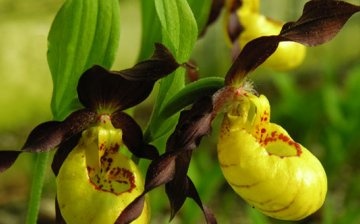
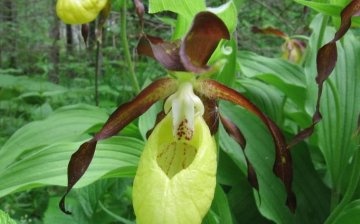

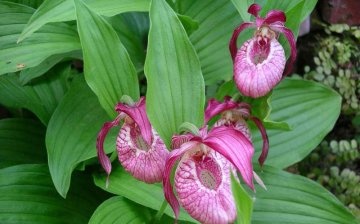
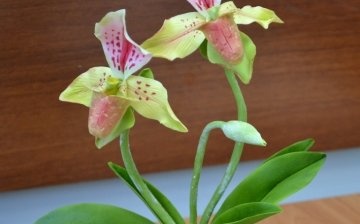







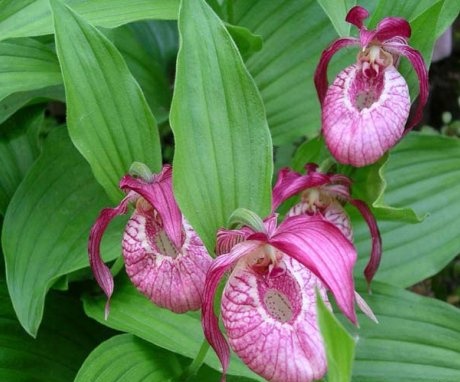
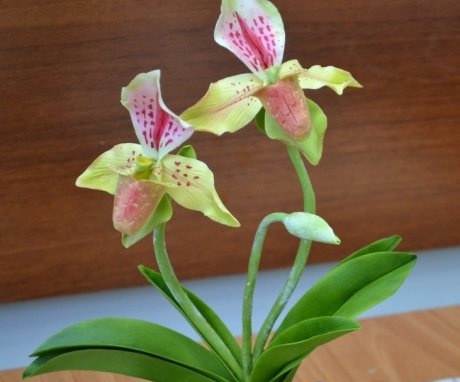
The Lady's Slipper Orchid is unusual in that for one flower, it always has one peduncle. I think that with such a feature, the flower is easier to plant by dividing the bush.